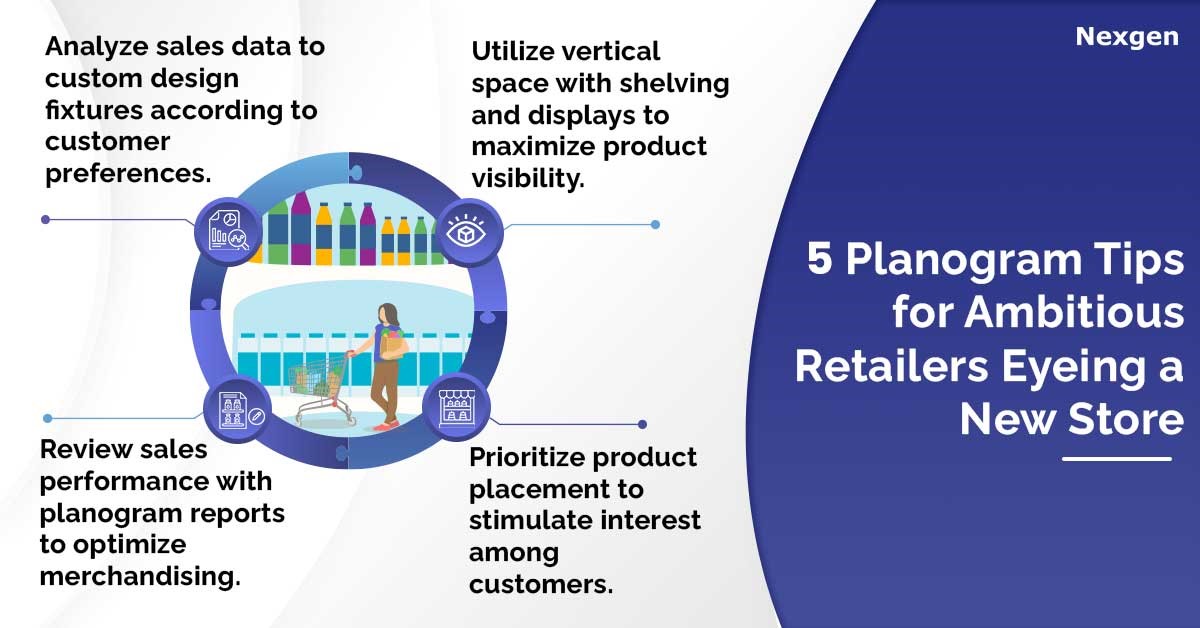Expanding your retail business by opening a new store is an exciting prospect, but it requires careful planning and execution to ensure success. One of the crucial elements in the success of a new store is the shelf layout and merchandising strategy. Planograms play a vital role in optimizing space, enhancing the shopping experience, and ultimately driving sales. In this blog, we will explore five planogram tips tailored for ambitious retailers planning to launch a new store.

1. Know your target audience.
Understanding your target audience is essential for effective planogram design. Before diving into the specifics of your new store layout, conduct market research to identify your ideal customer preferences, shopping behaviors, and expectations. This insight will guide your planogram decisions, from product placement to overall store ambiance, ensuring your new store resonates with your target demographic. Let us consider a retail store example of a health and wellness boutique targeting health-conscious individuals in a suburban area. Before finalizing the planogram for the new store, the owner conducts thorough market research to understand their target audience's preferences and expectations. With this insight, retailers can custom design fixtures with the help of planogram services for the new store to cater to their target audience.
2. Optimize shelf space.
Space optimization is crucial, especially in a new store where every square foot counts. Take stock of your available space and plan your shelf layout carefully. Utilize vertical space with shelving and displays to maximize product visibility without overcrowding the store area using planogram services. Consider the flow of foot traffic and strategically position high-demand products and impulse buys to capture customer’s attention and drive sales. Imagine a newly opened neighborhood grocery store aiming to cater to the diverse needs of its community while maximizing its limited space. Before opening its doors, the store's management conducts a thorough assessment of the available space and meticulously plans the layout to optimize shelf space. Understanding the flow of foot traffic within the store, the retailers strategically position high-demand products and impulse buys at key locations to capture customer’s' attention. Items such as fresh produce, dairy products, and ready-to-eat meals are placed near the entrance and in high-traffic areas to encourage impulse purchases.
3. Prioritize product placement.
The placement of products within your new store can significantly impact sales. Utilize planograms to strategically position the best-selling items at eye level and within easy reach of customers. Group complementary items together to encourage cross-selling and upselling opportunities. Additionally, rotate products periodically to keep displays fresh and stimulate interest among customers.
4. Flexibility is key.
While it is essential to have a well-defined planogram strategy in place, it is equally important to remain flexible and adaptable. Retail trends and consumer preferences are constantly evolving, so be prepared to adjust your planograms based on real-time data and customer feedback. Regularly review sales performance and customer behavior to identify areas for improvement and optimize your merchandising strategy accordingly. For example, an apparel store can use modular shelving units that can be adjusted in height and width to accommodate different product sizes and styles. By analyzing which products are performing well and understanding customer preferences using sales reports, retailers can adjust planograms to optimize sales and enhance the shopping experience.
5. Embrace technology.
Incorporating technology into your planogram strategy can streamline processes and provide valuable insights into your new store's performance. Consider investing in planogram software that allows you to create, visualize, and analyze your store layouts efficiently. These tools can provide actionable data on customer behavior, product performance, and overall store efficiency, empowering you to make informed decisions that drive success.
Overview of Nexgen Planogram Services
Nexgen offers store-specific planograms for clients that optimize sales and achieve category objectives. We create customized planograms for your business to ensure that these are better aligned with your goals and merchandising strategies. Our expertise in planogram automation helps us build planograms faster, better and consistently. Whether it is creating a planogram from scratch, or a typical reset, we have the knowledge, tools, and experience to get the job done for you.
Get Your Free Trial Now!